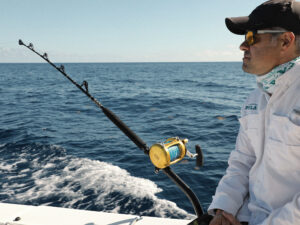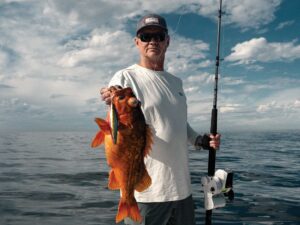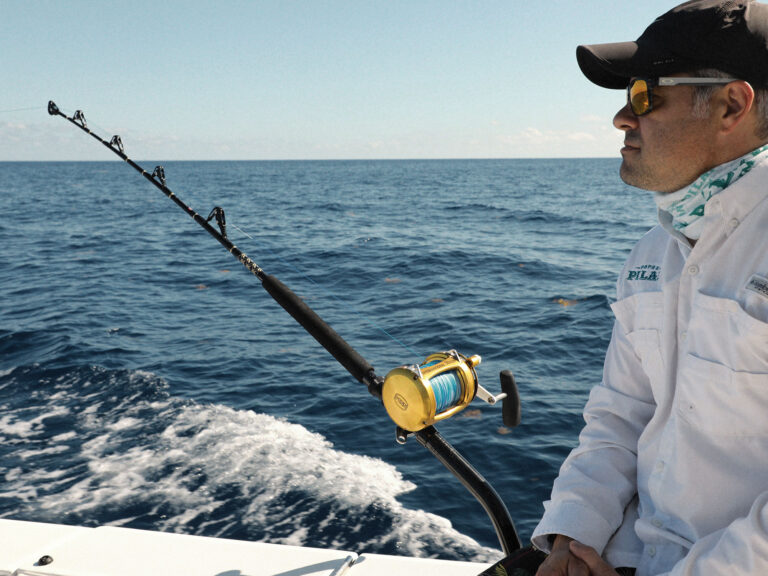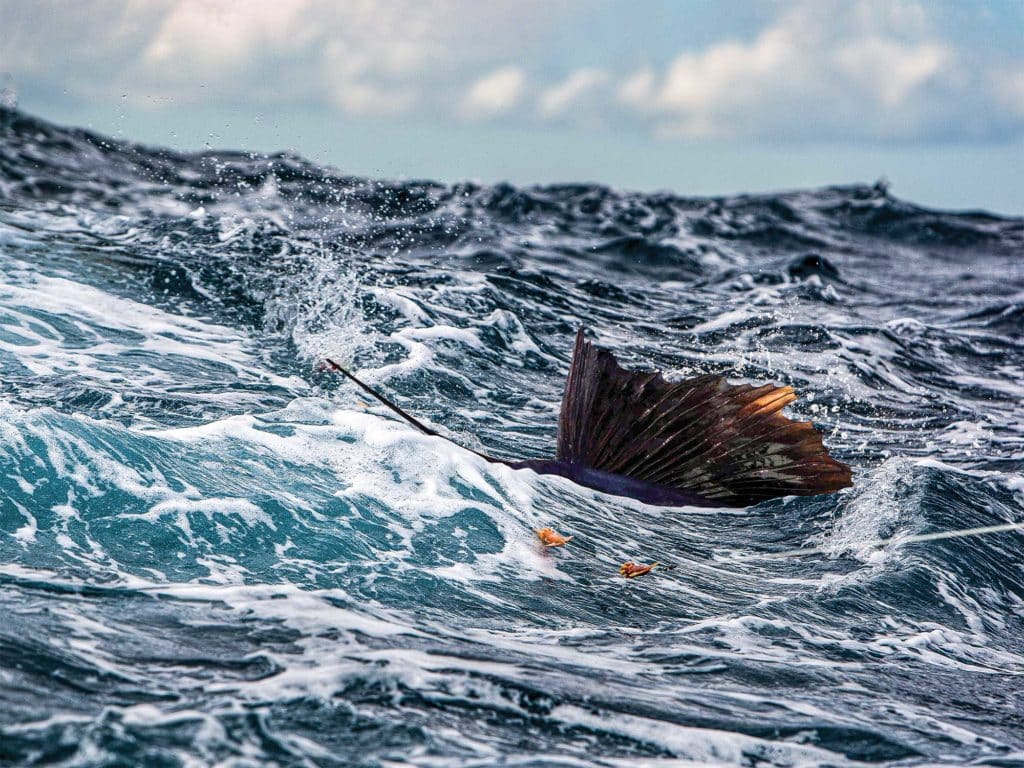
Successful live-bait sailfishing requires deep knowledge of this unique billfish’s migratory and feeding patterns. You need to understand how water temperature, current and wind direction influence such movements. You need specialized tech and behaviors. Then you need techniques to match these scenarios and teamwork to take advantage of them. Because proper gear is also critical, I’ve outlined all the tackle and equipment I use aboard my 33-foot CC. Use it as a blueprint if you’re looking to dial in similar rigs and tackle.
A Well-Rigged Boat
Good Sonar and Great Charts
Both are a must for locating reef -bottom jutting out into current, wrecks, bait concentrations and surface-temperature readings. Learn to look for places where north-flowing blue current washes over structure like this.
A High-Powered Livewell
My twin 34-gallon livewells are fed by a Hooker Sea Chest. Two 4,500 gph pumps circulate the water inside the chest itself, eliminating air infusion, dry pumps and pump failures at all boat speeds. The volume and velocity of water feeding each well, important for certain bait types, is controlled by a dial on my console. Another huge plus: The pumps are external and easily replaced.
Plenty of Power Outlets
To power electric kite reels, four 12-volt Hubble electrical outlets are positioned under the gunwales—two in the bow and a pair in the cockpit. That lets us drift or slow-troll a single kite off the stern, or drift a pair of kites utilizing both the bow and cockpit stations.
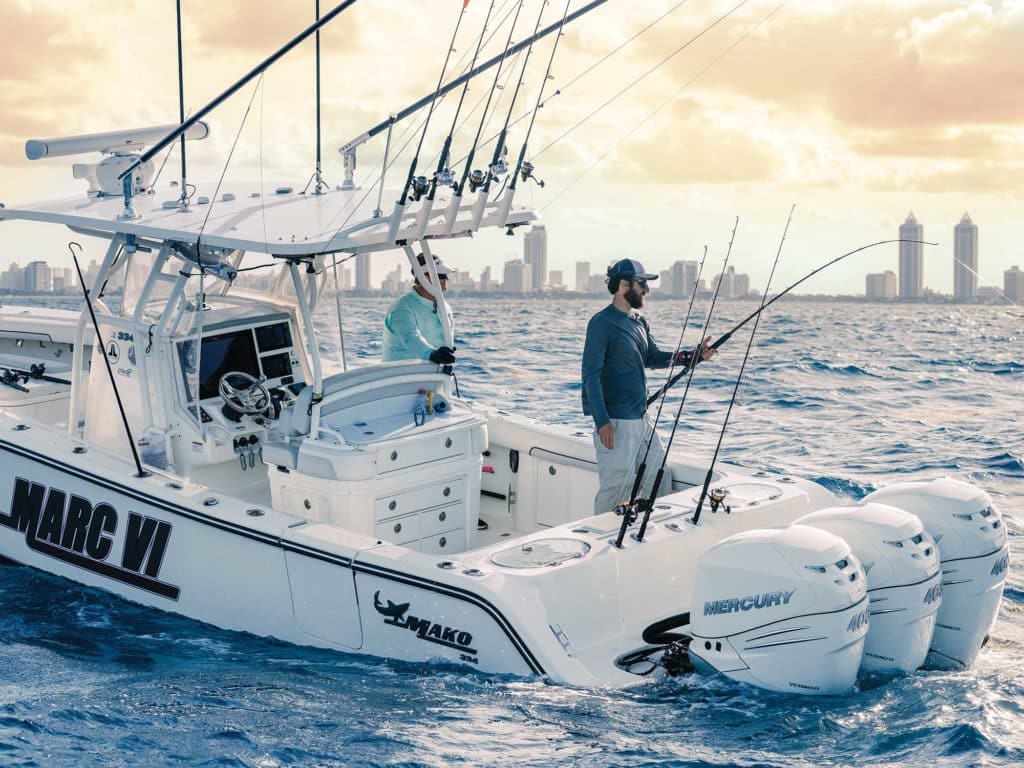
A Whole Lot of Rod Holders
A total of 26 gunwale-based Lee rod holders enable us to slow-troll live baits or drift a full spread complete with dual kites and flat lines.
For trolling, I’ve got two 30-degree Lee swivel rod holders and one 15-degree Lee flush-mount holder per side and within the aft gunwales. From there, eight more Lee holders are positioned along each gunwale and aimed seaward for drifting baits. A pair of Lee swivel rod holders occupy the bow, giving me the freedom to pivot as needed. Four zero-degree Lee holders are within the transom cap.

A Way to Spread Baits
Outriggers are ideal for spreading live baits and kites when slow-trolling. They’re excellent for placing additional baits. For example, my Lee 20-foot carbon-fiber poles and 15-foot carbon-fiber center rigger are each rigged to accommodate two baits per pole. When you use all three riggers, you can spread six live baits out behind the boat. Add in a pair of weighted flat lines and you’re up to eight baits (with more if you add a fishing kite).
Electric Reels for Teasers
Daisy chains can electrify a bait spread, whether live-baiting or towing naturals. Utilizing a pair of Elec-Tra-Mate Model 310 Pancake Teezer reels, I run my teaser lines through all three outrigger eyes and in the clean water to the outside of the boat. Keep the commotion up tight. If a fish rises on the teaser, pitch a live bait its way. The beauty of outriggers and teaser reels is that a boat will already be dialed in for trolling natural baits in areas that frown upon live-baiting for sailfish. Just add some dredges to build an underwater illusion.

Holographic Attraction
Similar to bump-trolling with daisy chains, a holographic dredge placed 10 to 15 feet down while drifting will enhance the illusion of baitfish holding near the boat. The more strips and holographic fish, the better.
Slow Your Drift
To counter a fast drift and give baits more soak time within a zone, deploy a parachute anchor sized to your vessel. For example, I keep a 15-foot, 20-pound Para-Tech Sea Anchor Parachute within the console of my 33-foot Mako.
Tridents for Kite Rigs
Trident rod holders are excellent for keeping outfits close to a fishing kite for easy station management. Strategically positioned gunwale rod holders can accomplish the same.
Top to Bottom Equipment
Electric Kite Reels
Based upon personal preference, fill 4/0- or 6/0-size reels with 60-pound monofilament, 80-pound Dacron or braid, or 50-pound braid for light wind. Rig with a minimum of three retractable release clips (different diameters to lock on their respectively sized swivels), followed by at least two additional swivels for clip-on release clips. The length of line from the kite to the first release clip is 80 feet, with 60-foot spacing between remaining clips and swivels.
Kites
Have at least one kite for each wind velocity: extra-light, light, medium, heavy and extra-heavy. And keep some backups handy. If a kite does end up in the brine, it will need a freshwater rinsing to rid it of salt crystals.
Kite Balloons
Filled with helium (don’t forget the tank) and affixed to the back of a kite for windless and light-wind days, these specialized 36-inch balloons also keep a kite afloat should it fall into the sea. A regular balloon affixed to the back of a kite during a breeze is also good insurance against a kite sinking, should it hit the drink. Use split shot when you’re flying two kites to spread them apart.
Egg Sinkers
Use egg sinkers from 10 to 16 ounces for your deep baits. Rig each sinker to several inches of 12-pound mono with a snap swivel at its opposite end. This snap swivel hangs on a short Bimini twist in your fishing line and remains open. When the sinker comes within reach, the open swivel is simply lifted from the Bimini twist, enabling the angler to wind their fish to the boat. Leaders are between 30 and 40 feet long on deep baits.
Terminal Tackle
A handy box with live-baiting essentials includes rigging needles, various sizes of rubber bands (for bridling), swivels, spacer beads, balloons, soft copper wrap, weights for kite floats, and ring guides (for joining fishing line to a kite release clip, avoiding wear on the fishing line).
Keep another box with easily accessible inline circle hooks in a variety of sizes. Fluorocarbon in 30-, 40- and 50-pound-test will be your go-to leader material. Naturally, 50-pound offers the best protection, but sometimes it’s necessary to scale down to 30-pound to get bites from wary fish. Scale down as needed to fool finicky fish—it’s better to break off a few than miss the hookup.
Read Next: Sailfish Can’t Resist These Trolling Baits and Lures
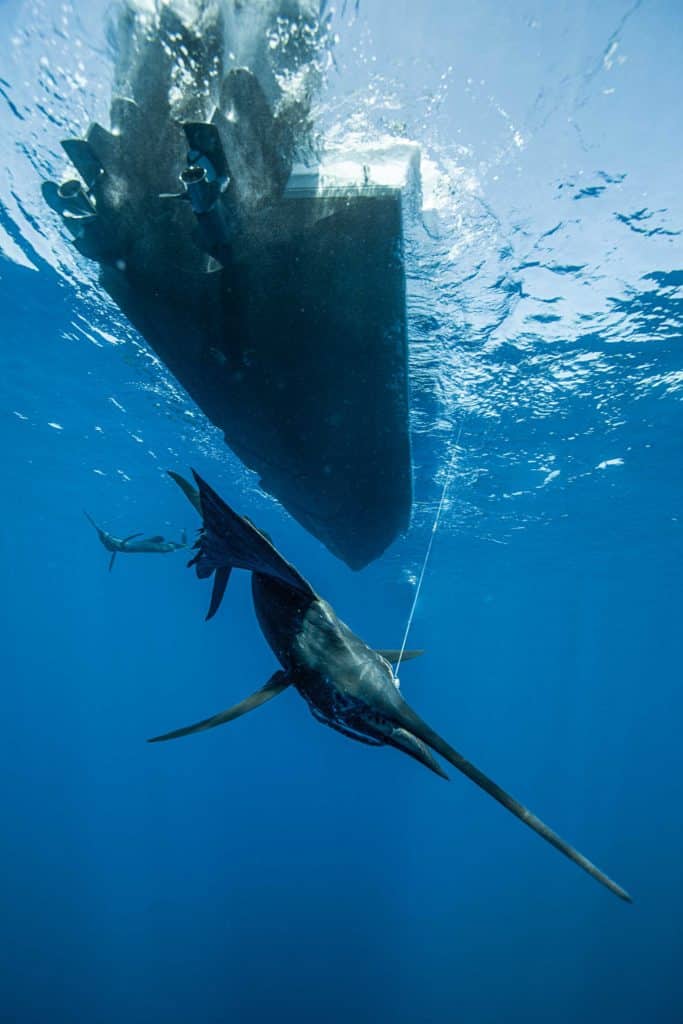
Game Plans for Scenarios
Sight-Casting to Bait Showers
Prominent in the Florida Keys, but also occurring along South Florida beaches when ballyhoo are solid, sailfish corral these baits over shallow patch reefs, often in clear water.
Our tackle consists primarily of spinning reels carrying a minimum of 300 yards of monofilament line, more specifically 6500 and 7500 Penn Spinfisher VI reels with 12-pound (6500) and 20-pound (7500) Sufix Superior monofilament and 40-pound fluorocarbon leaders. Rods are 7-footers rated for 20- to 40-pound-test lines.
Pin live ballyhoo to a 5/0 VMC inline Tournament circle hook by running the point down through the ballyhoo’s lower jaw and securing the shank in place with soft copper wrap. When sails are tailing or seen farther offshore, a belly-hooked live pilchard is best.
Prospecting for Followers
These same spinning outfits are good for prospecting for followers accompanying a hooked sailfish. (They can be deep and out of sight.) Here, I prefer 20-pound line to better control a sailfish and not exhaust it during battle (promoting a healthier release).
If a prospecting bait isn’t picked up initially, repeatedly recast near the hooked fish.
Flying Kites Downwind
We drift quite a bit with kites, covering downwind swaths of water with kite baits and upwind ones with our flat and D lines. Our conventional outfits are 7-foot rods rated for 30- to 50-pound lines and hold a minimum of 350 yards of mono.
Our kite outfits are a mix of Penn Fathoms, with 25N, 30 and 40 lever-drag models filled with 20-pound Sufix Superior monofilament. We’ll often bump up the kite leaders to 50-pound fluorocarbon because they’re not as apparent dangling from a kite. The leaders are 30 feet long, tied into a short double line in the main mono with a Bristol knot.
Slide a ceramic or metallic ring guide onto your main fishing line (which affixes to the kite release clip), followed by a 2- to 4-ounce egg sinker (based on bait size and wind velocity) and a marker float. Use different color markers to identify each outfit. Under the float and on the leader, we’ll knot a piece of No. 64 rubber band, which acts as a stop. Slide the stop to where you’d like to see the float on the leader. During the fight, and when the float reaches the rod tip, keep winding; it will slide down right near your fish.
Trolling Upwind
Spread the same types of outfits (minus the floats) among the upwind gunwales for drifting. Drop your leaders to 40 pounds and lengthen them to 40 feet. The latter is important for keeping your weights that much ahead of your deep baits.
With smaller baits, like pilchards, cigar minnows and herring, we’ll free-line them on 12- or 20-pound spinners.
These same conventional outfits can be used in slow-troll mode utilizing the boat’s outriggers, or in conjunction with a kite and its outfits.
Your Artificial Arsenal
- Mold Craft Junior Wide Range: This long-standing international favorite continues to rack up sailfish releases. Frank Johnson Sr., Mold Craft’s founder, developed the “soft head” concept so his lures would feel more natural to billfish. The formula seems to work.
- Capt. Harry’s Blue Boy: This 6-inch lure’s translucent skirt changes color under various light conditions and water hues. It basically lights up like a panicked bait with a predator closing in, a natural illusion that just might be the key in getting a window shopper to strike.
- Islamorada Flyer: A realistic flying-fish replica from the Florida Keys, the Original Blue and Silver Small Single Skirt lure is around 5 inches long. Its small, semi-round head is not prone to interfering with hook-sets. Soft, reflective wings also generate vibrations.


